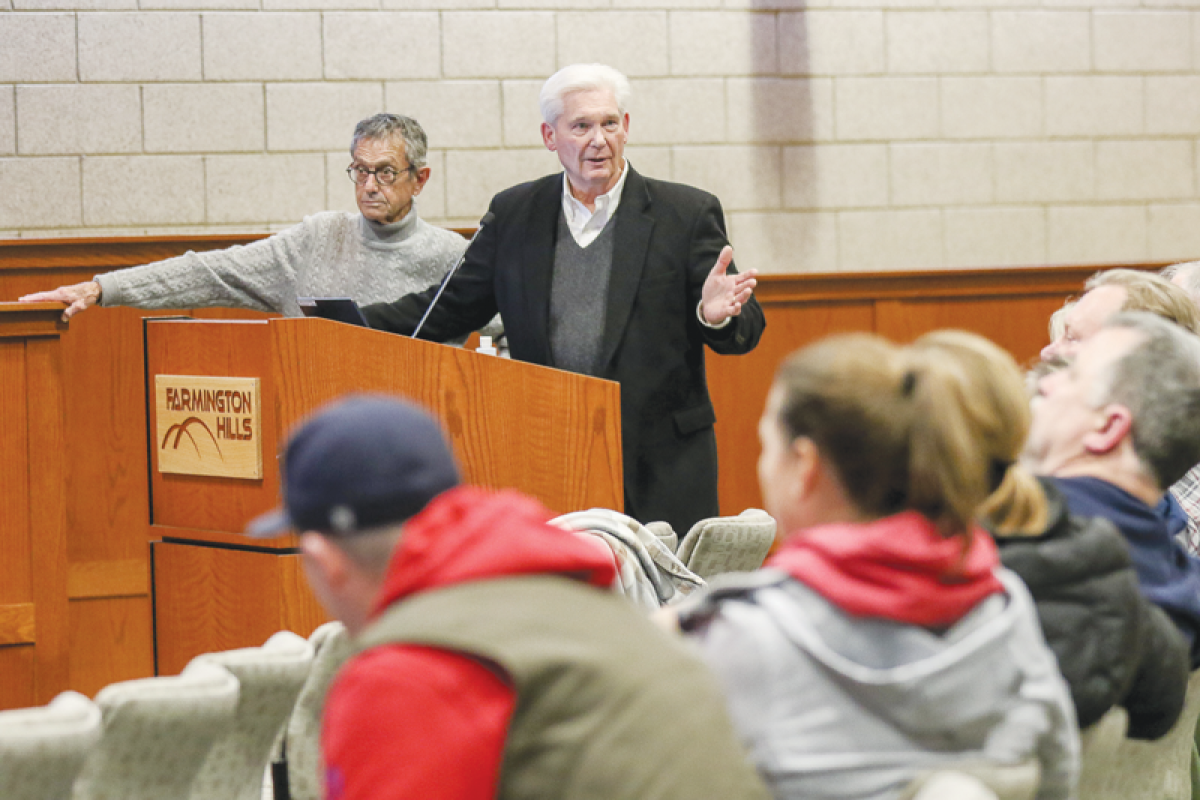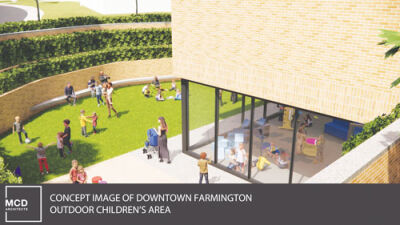FARMINGTON HILLS — A development proposal that has caused concern among some residents was addressed at a Farmington Hills Planning Commission meeting Feb. 15.
Forest at Riverwalk Development LLC is proposing 16 parcels for construction of single-family homes, with a one-family cluster option.
The location for the proposed development is on the south side of Folsom Road, between Parker Avenue and Lundy Drive.
Folsom is a service drive for the M-5 highway, and it runs from Farmington Road to Orchard Lake Road, said Michelle Gala, who is a resident in the area.
More than 15 residents expressed a variety of concerns at the meeting, including the impact to wetlands and wildlife, increased traffic, and the possibility of water runoff.
The size of the land is 16.29 acres. The developer wants to build more than 35 cluster homes.
Giffels Webster is a civil engineering company with locations in Oakland, Macomb and Wayne counties. One of the company’s consultants, Joe Tangari, spoke at the meeting.
“What the cluster option does is, it sets aside some of the land on a lot and it puts the units into a smaller area of the lot,” Tangari said.
Tangari explained that the process for a cluster development is to have three public hearings.
The Feb. 15 meeting was what he called the “qualification stage.”
It is the stage when a determination is made as to whether or not a plan meets the qualification criteria for cluster development.
“Conditions for qualification are basically two-tier, and (the) first tier allows certain density, and the second tier allows additional density,” Tangari said. “They (the developer) are requesting density that is lower than what’s permitted in the first tier, so we’re not going to address the second tier tonight because it’s not in question. The density that’s permitted is 2.6 units per acre under that first tier.
“What they’re showing on their plan is 38 units; the number of units that would be permitted at the maximum under that tier is 42,” he said. “We’ve noted, as they did, that (the department of Environment, Great Lakes, and Energy) will be required to weigh in on this before anything happens. … Under our master plan, this property’s designated (as) single-family residential.”
Toward the conclusion of the meeting, Planning Commission members unanimously approved the first stage of the developer’s proposal.
The second stage of the process involves the developer going back to the Planning Commission to try to get approval for a site plan. At press time, it was not known when that might occur.
If a site plan is approved, the next step would be for the developer’s plan to go to City Council for approval.
Tangari described the site as undeveloped and heavily wooded, with several areas of wetland.
One of the residents who spoke during the public comments section of the meeting was former Farmington Hills Councilwoman Mary Newlin.
Aside from the voices of the residents being heard, she said that they want to be “the voices for our 100-plus-year-old trees in the woods (and) all the wildlife.”
“The plan leaves a lot of questions,” Newlin said.
Paul Rusinowski is one of the residents who spoke at the meeting. He said that the woods are what enticed him to the neighborhood.
“We enjoy our life there. You guys are kinda trying to destroy that for us,” Rusinowski said. “My thing is, it looks like you’re trying to pack in as many houses as you can, in short space.”
Aside from a potential loss in property value, Rusinowski also expressed concern for what the development would mean for wildlife in the area.
“When you got something like natural woodlands like this, we’re running out of it in Farmington,” he said. “Where are all these animals going to go? I understand we’re growing as a population and you got to make accommodations, but we’ve got to think about the other side, too. … Put yourself in our shoes.”
Rusinowski also brought up the potential for water runoff at the site and asked, “Where’s that all going to go?”
Another speaker, Steve Hall, asked a similar question.
“I think we as homeowners have a right to know whatever plans are in place for that, if there are any,” Hall said. “Also sewage — where is that going to go? Right now we have septic systems … and groundwater can affect our septic systems. … We would like to know if the city is going to have a long-range plan to protect us as property owners when the developers are done with this and have left, and if we start having issues. Who’s going to be responsible for this?”
Representatives from the development company also had the opportunity to speak at the meeting.
Stuart Michaelson is a partner with Forest at Riverwalk Development LLC.
“The parcel contains natural assets which would be preserved through the use of cluster development; such assets may include large trees,” Michaelson said. “The land reserves the natural habitat for wildlife … and other natural assets which should be preserved.”
George Mager is also a partner with Forest at Riverwalk Development LLC.
“I know people here that are concerned about wetland preservation, (and) preservation of the trees,” Mager said. “We modified the plan to try to minimize impact on the wetlands and the trees.”
Michaelson also addressed concerns about water runoff.
“The water concerns — when we develop a new subdivision, we have to go through your engineering department,” he said. “We put in separate storm sewers; we drain. … We’re not going to add anything.”
Michaelson said that there is a “very thorough review of the sanitary and storm sewer system, and it’s all verified that this system is going to work.”
“We’ve been doing this for over 40 years, and I have personally never seen a failure at any of our systems,” Michaelson said.
From the perspective of local resident Denise Hall, there are other locations in the area that are more conducive for development.
She said that the area being considered for development is a beautiful piece of property with wildlife, such as deer, owls and hawks.
“I just hope you guys think twice about tearing down more woods just to build more houses,” Hall said. “There’s a lot of other places in the community that already have abandoned … strip malls. Take their spots — put in some houses. Put in some condominiums. … Don’t take down all these trees.”
Although Planning Commission member Steven Stimson stated that “there’s a lot on this I don’t like,” he also said, “I’m supporting this.”
“I’d like to give (the developer) a chance to come back, address the water concerns, work with engineering on it, work with EGLE on it, and let’s see what the plan is,” Stimson said. “Personally, I think the lot width’s way too narrow, and the homes are going to be right on top of each other, which I think is a little out-of-character for this area. But let’s see what you can come back with in a plan. … Also, I’d like to encourage you to work with neighbors and consult with them. … Try to work with them as much as possible.”
 Publication select ▼
Publication select ▼























